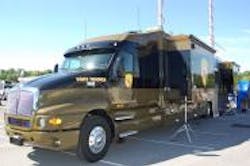“I tell you what – this truck makes some very wide turns.” –Charlie Lester, driver of the Maryland State Police incident command vehicle
It’s a one-of-a-kind truck that grabs your attention by both labels and holds on to them very tightly.
With its communication masts fully extended and high-tech computer stations deployed, the Maryland State Police incident command vehicle is an impressive sight. And it serves an important role, as well: that of an all-important “base camp” to help law enforcement combat all kinds of calamities, be they natural or man-made.
I got a chance to tour this impressive truck as the state police deployed it to help manage Operation Roadcheck out at the FedEx Field football stadium in Landover, MD, this week.
Built following the September 11 terrorist attacks, the truck functions as a mobile headquarters packed with a dizzying array of communications technology so the Maryland State Police can coordinate incidence response with any number of groups dealing with a crisis – local police, National Guard units, etc. – via radio, cellular, and even satellite communication networks.
It’s built on a specially-modified 2005 Kenworth T-2000 Class 8 chassis, powered by a 625 horsepower Caterpillar engine and 18 speed autoshift transmission. Though it’s got a clutch, the truck only needs to be manually shifted for the first few gears to get rolling. Once up to speed, the gears shift themselves so the driver can keep both hands on the wheel.
And both hands are certainly needed as this “straight truck” is 56-feet long from bumper to tail. Grossing out at 62,000 pounds fully loaded – weight that includes 300 gallons of fuel plus 300 gallons of fresh water.
Charlie Lester (at right, showing off the stacks of servers, cellular routers, generator controls, and other systems packed into this truck) is the incident command vehicle’s dedicated driver and told me he can raise the truck’s twin 56-foot tall communication masts and extend the work area compartments with just the touch of a button from the driver’s seat. However, he typically goes outside first to make sure nothing will be in the way when he fully deploys the truck for action.
Lester added that the truck comes equipped with two 20 kilowatt diesel-fired generators to power up the plethora of technology packed into its confines – computers, radios, fax machines, printers, and flat-screen televisions.
Four computer stations collect and manage all the communication traffic at a crisis site, while piping in television news feeds plus transmitting and recording video from one of five fixed security cameras around the vehicle, along with a mobile camera atop one of the masts.
Sergeant Ellis Diaz (at left) with the Maryland State Police told me the truck’s communication system is deliberately “layered” so it can tap into any available cellular network at an incident site – be it Verizon, AT&T, etc.
In rear of the vehicle is a miniature “conference room” of sorts equipped with television monitors, plug-in locations for laptops, and phones sp site commanders can quickly huddle up face-to-face to map our crisis response strategy.
Of course, since such a truck will literally be a “home away from home” during a crisis, it comes equipped with a toilet, two sinks, microwave, refrigerator and freezer.
[And let me tell you, having had too much coffee in preparation for covering the "Roadcheck" event, this reporter was MOST please to discover the truck came equipped with a bathroom!]
One thing for certain – it’s a vehicle ably suited to support the modern-day cavalry when it rides to the rescue.
